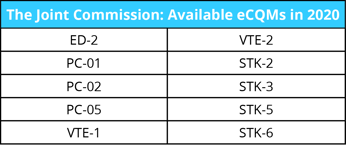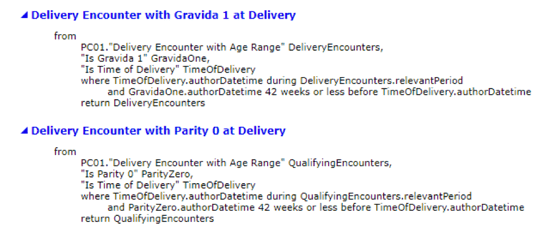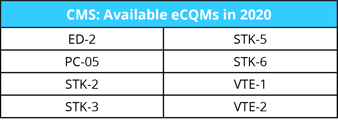The Joint Commission reveals new eCQM in 2020: ePC-02

The Joint Commission sent notification this week of their 2020 ORYX® requirements. That communication dropped an unexpected eCQM bomb on us – they are adding a brand-new eCQM to the mix. Our email inbox is full of questions on this significant change, so we thought we’d provide some additional information on what we know.
In a nutshell, The Joint Commission has diverged from CMS in their measure list and launched a new eCQM, ePC-02 (Cesarean Birth), which has never been an eCQM submission option for either agency.
Usually, TJC (The Joint Commission) aligns their ORYX® requirements to the CMS IQR program requirements. In previous years, we did see a slight difference in requirements where CMS retained STK-8 and STK-10 as eCQM submission options while TJC retired these measures. But this is the first time that TJC has added a new eCQM that wasn’t already an option in the CMS IQR program.
TJC 2020 Measure Changes
So, let’s talk about the changes overall and the differences that you need to be aware of when reviewing the 2020 eCQM requirements for CMS IQR vs TJC ORYX®.
- CMS is retiring seven eCQMs from their list in 2020.
- TJC is retiring six eCQMs from their list in 2020.
- TJC has 10 eCQMs to choose from, CMS has eight.
- TJC is keeping ePC-01 (Elective Delivery) as a submission option; CMS is retiring this eCQM.
- TJC is adding ePC-02 (Cesarean Birth) as a submission option; this eCQM is not a submission option for CMS.
2020 TJC vs CMS Measure List
Here’s the comparison list of available eCQMs for 2020.
 |
|
Understanding the PC-02 eCQM
Here’s where I take a deep breath, because that’s a lot of change, and a lot to keep up with in an already “busy” eCQM world. So, let’s start by looking at what I think is the biggest and potentially most important (yet challenging) change. That is the addition of ePC-02.
By now, everyone should be relatively comfortable with eCQMs.
I mean, we’ve been doing this for 9 years now right?!
And to be totally honest, I was way too excited when I read that there was a new eCQM coming out. Don’t tell my kids, they already think I’m nerdy enough.
But even I know, after years of staring at these eCQMs, that implementing a new measure can be challenging (and maybe just a little bit intimidating) to say the least. Why bother?
This is my favorite part…
BECAUSE implementing this measure correctly will give you an additional option for TJC submission, and it provides valuable information you can use for quality improvement at your hospital.
Not to mention, that TJC has hinted that at some point in the future they may publish eCQM results, and/or add additional requirements around performance.
You want to be ready for that right?
PC-02 eCQM Specification
So, let’s take the first step, and look at the specification for ePC-02.
This part is easy, trust me.
You are probably familiar with the chart-abstracted version of this measure which NQF has endorsed since 2008. Now we have a new electronic version. At first glance, the measure actually doesn’t look that hard to implement; especially compared to the PC-01 eCQM which is insane.
By the way, this spec was near impossible to find on the web so you’re welcome!
Step one. Make sure you understand the measure intent before you dive into the rest of this spec. In this case, the measure description, as documented in the spec is: “Nulliparous women with a term, singleton baby in a vertex position delivered by cesarean birth.”
Got that?
If you have a clinical background you know this translates to: This measure assesses the rate of cesarean delivery in women giving birth for the first time. It only counts mothers giving birth to one baby that’s in the head down position.
The measure steward is TJC for both the abstracted and now eCQM version.
PC-02 eCQM Populations
Below is a quick summary of each of the populations for this measure, which hopefully will give you a quick understanding of how the rates are determined.
Initial Patient Population: Patients between the age of eight and 65 with a delivery procedure and length of stay less than 120 days.
Denominator: Those in the initial population for whom this is their first pregnancy and no previous births. It must also be a single birth and ≥37 weeks gestational age.
Exclusions: Abnormal presentation at delivery or placenta previa.
Numerator: Remaining encounters with cesarean birth.
Well that’s not so bad right? That’s what I said until I started looking at the logic for capturing something simple like Gravida and Parity…

Cue the deep breathing again.
I mean, what does time of delivery and author date and time have to do with either of these things? Why can’t they just say, “document gravida” and “document parity”?
Obviously, as always, the population descriptions are a bit misleading, and that’s why it’s so important to review and understand the measure logic in preparation for implementing eCQMs.
The good news for you is that I will be spending some time studying this measure and probably getting on the phone with TJC.
|






Comments